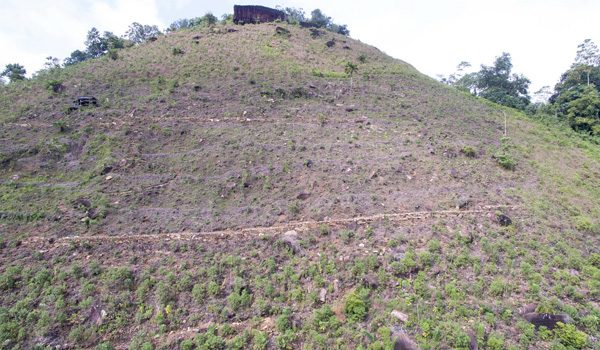
Home to over half of the world’s plant and wildlife species, tropical rain-forests support the greatest diversity of living organisms on Earth; their high species abundance is thanks to the warm climate causing higher rates of metabolism, ecological dynamics and co-evolutionary processes. Sadly, today, global rainforests cover less than 2% of the Earth’s surface.
Thus, protecting rainforests is very important not only to safeguard the world’s biodiversity, but also to mitigate climate change and it was this that inspired the Wildlife and Nature Protection Society (WNPS) to attempt to restore a ravaged rainforest in the country.
Sri Lanka has one of the highest deforestation rates of primary forests in the world and its rainforests, which were once distributed over 26% of the land, have been drastically reduced to about 2% today. The Sinharaja Forest constitutes most of this remainder and was granted the title of a Biosphere Reserve and World Heritage Site by UNESCO; it is listed as “a place of special significance to the common heritage of humanity”.
Diyakothakanda
Situated in the south-west lowland wet zone of Sri Lanka and falling into the Sabaragamuwa and Southern Provinces, Sinharaja is surrounded by a buffer zone which was once pristine rainforest, but since cleared for tea plantations and other cultivation. The Forest Department made WNPS guardians of Diyakothakanda, a mountain slope on the borders of Sinharaja in the vicinity of Dikhena, a village about 14 km from the Badureliya town in the Kalutara District.

Thus began the Reforestation of a Rainforest (ROAR) Project.
Once draped in forest cover, it was no more than a rocky, gravel-filled mountain slope, dry as a biscuit and devoid of much life. The WNPS, in partnership with five schools of the area, began the task of restoring the five-acre (two-hectare) plot of land back to a rainforest.
Linking conservation, science, community development, education and youth, the project is testimony to the incredible impact of collective action.
First time in Sri Lanka
Having consulted Sri Lanka’s two foremost tropical rainforest experts, Profs. Nimal and Savitri Gunatilake, it was decided to employ a Relay Floristics Method of reforestation. It would be the first time in Sri Lanka that an attempt was being made to restore a destroyed rainforest through science-based human intervention.
When using this method, plants of different succession stages are introduced, at different times, as the existing soil condition has been degraded beyond repair and are unable to naturally facilitate the growth of later succession species. Once the early succession species have improved the soil, and provide shade, the later succession species are able to more easily take root.
The first step in the project was to remove the Wire fern Dicranopteris linearis (S. Kekilla) which had infested the degraded soil of the mountain slopes. Kekilla is incredibly difficult to eliminate, so a scientific method was needed to strategically remove this invasive plant species. Initially, much of it was manually uprooted. Then, pioneer rainforest species such as Kanda (Macaranga peltata), Geduma (Trema orientalis), Varaniya (Hedyotis nitida), and Bovitiya (Osbeckia octandra) were introduced in the cleared spaces. The hope was that these sun-loving pioneers would grow rapidly and form a canopy blocking the light from the Kekilla below, thereby killing it off. This is exactly what took place and the required environment for the planting of early succession and climax forest trees was created. These saplings were collected from the natural forest and planted under the shade of the pioneers.
 |
| Chandrasiri,villager associated with the project from the inception; Prof Nimal Gunatilleke, Chief Consultant; Prof Lakdas Fernando, Chair of the WNPS ROAR project; Dr Nirmalie De Silva, Member of the WNPS ROAR subcommittee; Charith Madhushan, Project Coordinator and Dr Suranjan Fernando, Project Advisory Team |
Nature’s miracle
In a natural ecosystem, flora and fauna are dependent on each other. So as expected, once the flora started being established at Diyakothakanda, the fauna began to return. The return of more birds, butterflies and mammals, such as sambhur, mouse deer, porcupine and pangolin, have been a welcome sight.
At the Asia Pacific Chapter Meeting of the Association of Tropical Biology and Conservation (ATBC) in Sri Lanka in September 2019, Professors Nimal & Savithri Gunatilleke made a presentation on the project at Diyakothakanda. They hailed it as a sustainable model for Sri Lanka, using a mixture of early and late succession species, with a strong representation of native and naturalized species, resulting in an optimal rate of growth.
The initial sponsors of the project were Rotary Club Colombo West, Teejay Lanka PLC and Bureau Veritas Consumer Products Services Lanka (Pvt) Ltd, and WNPs also gratefully acknowledges the continued sponsorship of Ajita de Costa in memory of his late father Ray de Costa.
The WNPS’s ROAR Project is a testament that with focus and investment (in time, passion and finance), a rainforest can be brought back to life with sustained attention and scientific guidance.
“The goal of ROAR is to restore and link a thriving Diyakothakanda to the Sinharaja Rainforest, making it a contiguous whole. Rainforests are easy to destroy but difficult to re-grow. The ROAR Project will encourage generations of schoolchildren to track the progress of a rainforest from ‘planting to completion’ by maintaining data scrupulously and keeping records of the fauna and flora that inhabit the plots allocated to them”- Prof Lakdas Fernando

Leave Comments